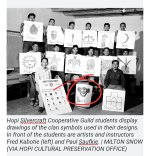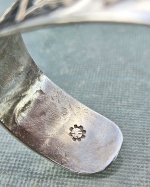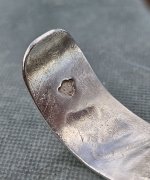tamrock
Gold Member
- Jan 16, 2013
- 15,480
- 31,469
- Detector(s) used
- Bounty Hunter Tracker IV
- Primary Interest:
- All Treasure Hunting
I picked this up for $20.+ tax today. With a bit of scanning the web for the pictorial makers marks, I found it was made within the Hopi Silvercraft Cooperative Guild.
https://www.arizonahighways.com/article/hopi-jewelry There's still some investigation left to do, which is a stamped mark of a bears face, which may only be the symbol of a particular Hopi clan. The sun stamp is what lead me to identifying this silver smithing cooperative of Hopi students taking up the art of producing silver from one instructor named Fred Kobotie, who seem is a rather acclaimed Hopi artist https://en.m.wikipedia.org/wiki/Fred_Kabotie It weighs 32 grams and with that I did get it below spot value, but I feel fairly certain it's worth much more than that. How old it is I can't really determine.
https://www.arizonahighways.com/article/hopi-jewelry There's still some investigation left to do, which is a stamped mark of a bears face, which may only be the symbol of a particular Hopi clan. The sun stamp is what lead me to identifying this silver smithing cooperative of Hopi students taking up the art of producing silver from one instructor named Fred Kobotie, who seem is a rather acclaimed Hopi artist https://en.m.wikipedia.org/wiki/Fred_Kabotie It weighs 32 grams and with that I did get it below spot value, but I feel fairly certain it's worth much more than that. How old it is I can't really determine.
Attachments
Last edited:







